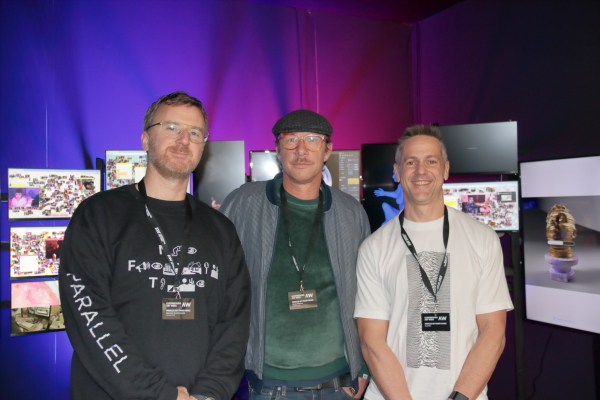 (L-R) Alex Czetwertynski, co-founder of Parallel.art; Nicolas Wierinck, co-founder of Parallel.art; Casey Alt, Bitmark and Feral File;
Credit: Kangkan Halder
(L-R) Alex Czetwertynski, co-founder of Parallel.art; Nicolas Wierinck, co-founder of Parallel.art; Casey Alt, Bitmark and Feral File;
Credit: Kangkan Halder
Chronicle.lu recently had the opportunity to speak with Alexandre Czetwertynski, co-founder of Parallel.art, who was present recently at the eighth edition of Luxembourg Art Week, to learn more about the emerging field of non-fungible tokens (NFTs) in the digital art space.
Parallel.art had a unique booth at Luxembourg Art Week, where visitors wishing to learn more about art-related NFTs could interact with the team and gain first-hand experience of the digital ownership of artworks.
Chronicle.lu: Please introduce the company you co-founded, Parallel.art, and the how digital art ownership through NFTs works.
Alex Czetwertynski: Parallel.art is an NFT advisory, consultancy and commissioner. We work with artists, institutions, galleries and art fairs to help develop web3 strategies and push the NFT space forward.
There have been varieties of experiments over the years to assign ownership to digital assets. This has been challenging because digital assets are, by default, replicable. The blockchain is a new type of technology that allows for ownership to be assigned in an undisputable way. It was originally created to secure digital transactions and balances, and it has proven over the years to be a reliable way to secure digital assets.
Chronicle.lu: Please elaborate on the value behind digital NFTs and what is the future of digital artworks.
Alex Czetwertynski: The value of NFTs, just like the value of traditional art, is a difficult thing to pin down. It depends on a variety of parameters, such as an artist's popularity, their reach on social media, the early collecting of the work by notable collectors, etc.
The difference with the traditional art world is that, for now, galleries have less of a role to play in the pricing of the work, but little by little, as artists request it, galleries will have to start getting involved and integrate NFT pricing in the overall price strategy for their artists.
The future of digital artworks is quite bright, because NFTs unlocked a series of potential developments. Artists are already pushing new boundaries and creating artworks that would have been unthinkable a few years ago. For example, since ownership is being tracked, the artwork can change shape as it changes hands, or evolve over time, etc.
Chronicle.lu: How does a digital wallet to keep digital assets like artwork work?
Alex Czetwertynski: A digital wallet is essentially a blockchain "reader". Once you attach your unique address(es) to it, it will check for any assets associated with your identifier, and allow you to display them in a unfied interface. Some wallets are used only for NFTs, other for Cyrptocurrencies and NFTs.
Chronicle.lu: Please elaborate on how the whole transaction works, from digital currency to NFT ownership.
Alex Czetwertynski: The accepted way to purchase an NFT is to start by owning cryptocurrencies. Today various companies allow you to make these transactions using "fiat" (credit cards essentially) and manage the conversion to cryptocurrencies in the back end.
When you pay for an NFT, you transfer a certain amount of cryptocurrency to an account, and once that amount has been transferred, the NFT's ownership changes and is assigned to the new buyer. This is recorded on the blockchain, so the entire chain of ownership can be seen by anyone.
Chronicle.lu: Does one need to have cryptocurrency to buy NFTs?
Alex Czetwertynski: Depending on the platform, it will vary. In most cases yes.
Chronicle.lu: Which blockchains are used by Parallel.art to verify the transaction and ownership of an NFT?
Alex Czetwertynski: Parallel is blockchain agnostic, we work with a variety of blockchains depending on the project.
Chronicle.lu: During Luxembourg Art Week, you offered free NFTs. What was the motivation behind this free offer?
Alex Czetwertynski: We know that the majority of visitors to the fair will be new to NFTs and we also know that owning your first NFT is a good way to understand what it feels like and could motivate you to start exploring the market.
Chronicle.lu: Can NFTs be given or shared with other people? How does it work?
Alex Czetwertynski: They can be transferred, rented, used as collateral etc. This is all defined in a software layer called "Smart Contracts". These are the core buidling blocks of NFTs that organise all the different types of operations one can do with NFTs. In a sense, we can call NFTs "programmable art", meaning software written on the blockchain can perform certain operations on the artwork based on the ideas that make sense for this new field.
Chronicle.lu: What are the main advantages and disadvantages of a physical artwork compared to a digital artwork, to consider before one decides on a NFT?
Alex Czetwertynski: That is a bit like comparing real estate investing to investing in bonds or commodities. They can both exist simultaneously and present different advantages.
A piece of digital art is an interesting acquisition if one appreciates digital art and wants to grow a collection in this field. But like with any art buying, one has to explore the field and develop one's understanding.
Chronicle.lu: How does an independent creator of a digital artwork register or sell artwork digitally?
Alex Czetwertynski: A number of platforms have been created to help with this process, such as Versum.xyz/Objkt.com (for tezos) or Opensea.com, Rarible.com, Foundation.app, Zora.co etc. (for Ethereum or other currencies).








